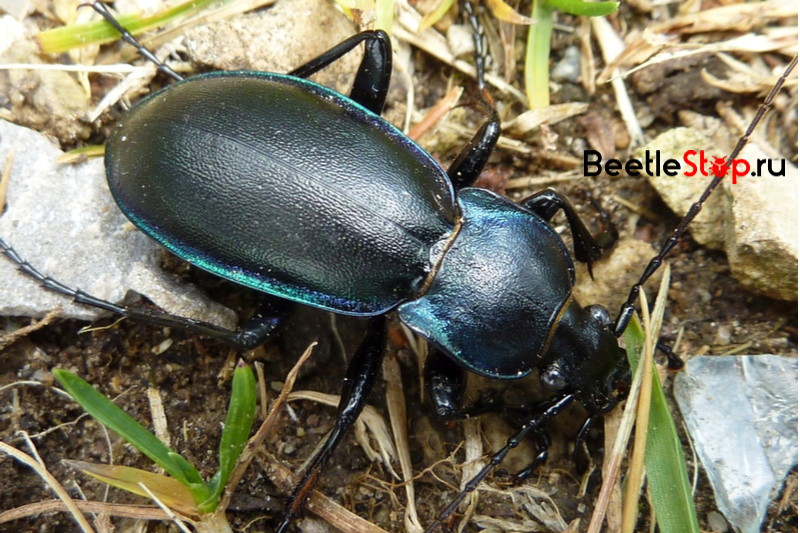Convex beetle - a mollusk hunter
The genus Carabus is one of the most numerous groups in the ground beetle family (Carabidae). In the world described 850 species common in the Holarctic. Dozens of new insects are found annually. The greatest diversity of species occurs in mountainous regions. Convex beetle - a representative of the suborder of carnivorous beetles. The insect has a black shiny body with a bluish tint at the edges of the elytra. The main diet is terrestrial mollusks: slugs, snails, and earthworms.

Morphological description of the species
The family of ground beetles (Carabidae) has united many genera and up to 50 thousand species. Its representatives are predators and herbivorous insects. Convex beetle (Carabus convexus) is a large beetle with a size of 15-18 mm, belonging to the genus Carabus. The body is elongated, convex elytra covered with small longitudinal grooves. The main coloration is black with a metallic sheen, the shield of the pronotum and the margins of the elytra have a characteristic blue hue.
The head is directed forward, partially drawn into the prothorax. Powerful pointed mandibles determine a predatory lifestyle. The sickle shape of the organ contributes to the retention of the victim. There are teeth on the side groove. Maxilla (second pair of jaws) with 4-segment tentacles. The last segment ends with an extension in the form of an ax. The eyes are complex, spherical in shape, large. No eyes. Antennae long, filiform, composed of 11 segments. on the first segment there is one bristle.
The articulation of the pronotum and elytra is narrowed, this indicates the mobility of the front of the body. Pronotum wide, lateral parts elevated at edges. In the central part there is a noticeable tubercle surrounded by a recess. Fine grain on the surface. Hind angles in the form of triangular lobes extend beyond the base of the pronotum. Abdomen with six sternites, lower part covered with transverse grooves.
Information. In case of danger, the carabuses release a stream of caustic liquid from the anus. In contact with human skin, it causes irritation.
Fused elytra and reduced wings deprived insects of the ability to fly. The only way they can travel is by running and crawling. The extremities of the beetles are long and muscular. Well adapted for walking and running. The front tibia has a hole designed to clean the mustache after eating. The foot is 5-segmented.
Sexual dimorphism
One can distinguish between a ground beetle male and a female by the structure of the legs of the forelimbs. Their segments are flatter and wider than on other pairs of legs. Also, individuals are distinguished by the shape of the apex of the abdomen. In the female, the abdomen edge is pointed, in males it is sloping.
Distribution area
The beetle lives in the north of Europe - in Sweden, Denmark, Norway, Finland. Worldwide distribution from Western Europe to Siberia.
Lifestyle & Reproduction
Beetles can be found on the plain and in the highlands. The species belongs to mesophilic insects that grow and develop best in temperate climates. Beetles are found on natural pastures, agricultural fields, open meadows with heavy soils, in bright deciduous forests. The view is usual for the forest-steppe zone. Convex beetle is active at night.In the afternoon he spends time in shelters: under stones, tree trunks or buried in the litter.
The predator specializes in slugs, earthworms, insects and their larvae. Beetle can be seen by sucking the juice of overripe berries. Eating snails, beetles do not scatter its integument, but immerse its head and part of the pronotum at the mouth of the shell.
Breeding
Beetles mate and lay eggs in early summer. One generation is developing in a year. Females lay eggs in moist soil. Larvae appear after 2 weeks. They are the same predators as their parents. The offspring has a campodeiform shape, the upper part of the body is sclerotized. Extra-intestinal digestion is characteristic of the larvae. Using sharp mandibles that have a special channel inside for the release of a food enzyme, they inject poisonous liquid into the victim’s body. The mouth gap is closed, insects suck out a nutritious cocktail through the channels of the mandibles. Ground beetles hibernate at the adult stage. Pupation occurs in an earthen cradle.
Protective status and limiting factors
In many places, the species is reduced in number, falling under the category of vulnerable. In the Republic of Tatarstan, convex beetle is listed in the Red Book. Over 10 years of entomological collections in the region, only 20 adults were found. Limiting factors:
- deforestation;
- chemical treatment of habitats;
- reduction of the area of meadows and fields.
The species is protected in the Tambov region, is listed in the regional Red Book.

